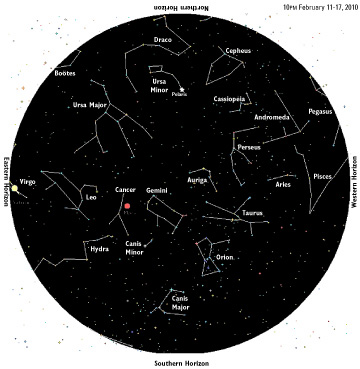Chesapeake Bay's Independent Newspaper ~ Since 1993
1629 Forest Drive, Annapolis, MD 21403 ~ 410-626-9888
Volume xviii, Issue 6 ~ February 11 - February 17, 2010
Home \\ Correspondence \\ from the Editor \\ Submit a Letter \\ Classifieds \\ Contact Us
Best of the Bay \\ Dining Guide \\ Home & Garden Guide \\ Archives \\ Distribution \\ Advertising![]()


Sky Watch

by J. Alex Knoll
Milkier than the Milky Way
How bright can a little dust be?
A thin crescent moon wanes through pre-dawn skies at week’s, but come Sunday it has vanished amid the glare of the sun. Monday evening, just minutes after 5:45 sunset, a thin sliver of the nascent moon appears low in the west before setting at 7:30. Following nights, the moon appears 10 degrees higher in at sunset and remains visible an hour longer.
These moonless winter nights — at least those not obscured by snow-filled clouds — are your best chance to see the zodiacal light in the evening sky. It appears as a dull glowing pyramid, stretching from the horizon where the sun set up to the heavens’ zenith. Perhaps you’ve even seen the zodiacal light, sometimes called false dawn, confusing it for the glow of twilight at dusk or dawn.
However, unlike twilight’s ruddy glow, the zodiacal light is bereft of color. While twilight is caused by the last rays of sunlight interacting with earth’s cloudy atmosphere, the zodiacal light is caused by sunlight striking countless bits of interplanetary dust orbiting the sun. Just as with the planets, what we’re seeing is the reflection of this light.
Completely encircling the sun, this mass of dust travels along the ecliptic just as the moon, the planets and the constellations of the zodiac do. The dust specks range in size from a mere fraction of a millimeter to a few millimeters across. Occasionally we get a better look as a piece collides with our atmosphere, igniting into a meteor.
The zodiacal light appears in the west only after the onset of true astronomical darkness, roughly 90 minutes after sunset hereabouts. If you’re within the glow of a city, you may never attain astronomical darkness. How to tell? If you’ve seen the Milky Way from your viewing spot, you should be OK. Once you see the zodiacal light, you might be surprised at how illuminated it is, appearing even milkier than the Milky Way.
Illustration: © Copyright 1925 M.C. Escher/Cordon Art-Baarn-Holland; Graphics: © Copyright 2010 Pacific Publishers. Reprinted by permission from the Tidelog graphic almanac. Bound copies of the annual Tidelog for Chesapeake Bay are $14.95 ppd. from Pacific Publishers, Box 480, Bolinas, CA 94924. Phone 415-868-2909. Weather affects tides. This information is believed to be reliable but no guarantee of accuracy is made by Bay Weekly or Pacific Publishers. The actual layout of Tidelog differs from that used in Bay Weekly. Tidelog graphics are repositioned to reflect Bay Weekly’s distribution cycle.Tides are based on National Oceanic and Atmospheric Administration and are positioned to coincide with high and low tides of Tidelog.
© COPYRIGHT 2010 by New Bay Enterprises, Inc. All rights reserved.
